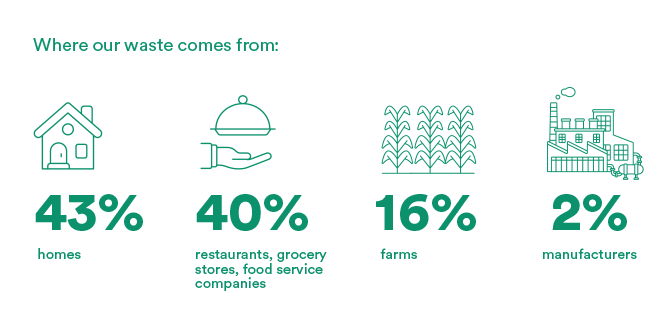Do you always finish your food? I personally cannot guarantee I never waste any food in my life. I also think many others are the same. Food waste has been an issue that contributes to the worsening of climate change. In the US, 43% of food waste comes from residential, 40% comes from restaurants, grocery stores, and food services companies, 16% comes from farms, and 2% comes from manufacturers.

As you can see most food waste actually comes from us! We tend to buy more than we need due to the factors of discount influence, occasional planning, and even just for pleasure. The SDG 12 set by the United Nations targeted global food waste reduction by 50% hoping to achieve it at the end of 2030. We have 6 more years to go and right now no official reports are showing any progress in food reduction. However, the EPA defined food waste to be managed in the following pathways: landfill; controlled combustion; sewer; litter, discards, and refuse; co/anaerobic digestion; compost/aerobic digestion; and land application.
Other than consumers, businesses also played an important role in cutting food waste. In 2022, Ikea announced saving more than 20 million meals over four years. This is the first company of its scale to meet its food waste reduction goals—and they did it over just a few years. As of now, another company turns food waste into something more interesting- the Royal Caribbean Cruises.
Its cruise ship, Icon of The Seas is a cruise ship built for Royal Caribbean International and is the lead ship of the Icon class. The ship has a crew of 2,350, and a capacity of 5,610 passengers at double occupancy, or 7,600 passengers at maximum capacity- making it the largest cruise ship worldwide.
It’s “the biggest, baddest ship on the planet” – Jason Liberty (CEO of Royal Caribbean Group)
So how can this ship be sustainable? Icon of The Seas actually is the first ship in the Royal Caribbean fleet to be powered by cleaner-burning liquified natural gas. But that’s not the best part, the best part is inside of their buffet restaurants.
Chefs can cook up to 4000 lobster tails and 40000 desert portions daily to serve thousands of people. To maintain a sustainable environment, they separated the food waste into two types: the waste from food preparation and the waste that is served. To reduce the food waste that is not eaten, workers measure buffet food items before they are served. After the buffet closes, they collect the leftovers and weigh them to compare how much is served and how much is eaten. This is an efficient strategy to adjust food quantity and portion sizes.
Then all food waste would eventually suck into food pulpers and then travels into pipes underneath where passengers dine. There will be a center for all the food waste to be stored and through a system called Microwave-Assisted Pyrolysis (MAPS), this food waste will be dried into pallets to fuel the ship. It allows the ship to reduce waste onboard and the pallets roughly generate about 200 kilowatts. Although it provides a relatively small amount of energy, it can still operate almost the entire waterpark on the ship. In the future, Royal Caribbean set an optimistic goal of increasing 200 kilowatts to 300 kilowatts.
However, to operate a large cruise like the Icon of The Seas, 300 kilowatts is a minuscule amount. When the cruise ship is stationary, it needs about 10,000 kilowatts for energy, and while on cruising, it needs about 30,000 kilowatts. This means that MAPS only helps to generate less than 2% of the energy. Thus, there is still a long way to go, but it is a very good start.


Food waste is definitely an important issue, especially at a university like Penn State. So much food can go to waste, and by finding a new use for it similar to what was used on the cruise ship, positive outcomes can result, like new energy sources. Do you believe the method used on the cruise ship could be applied to other industries or places in order to reduce food waste in multiple communities?